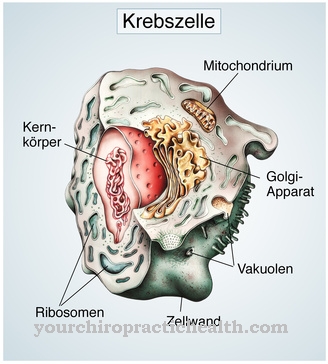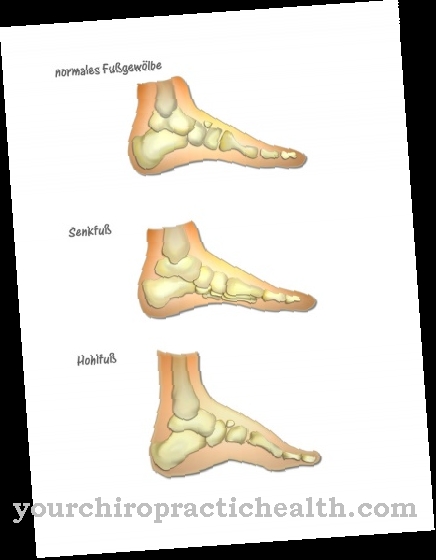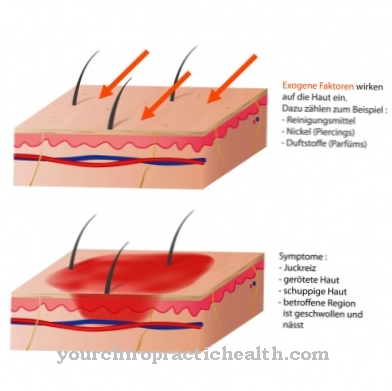Under the Greig syndrome medicine understands a congenital malformation syndrome, which is mainly associated with facial deformities and a multiple number of fingers and toes. The hereditary syndrome is not curable, but can be treated surgically. The prognosis for patients with the mutation-related disease is excellent.
What is Greig Syndrome?

© sarawut795 - stock.adobe.com
Greig syndrome will too Greig's cephalopolyndactyly syndrome and is a congenital malformation syndrome associated with congenital abnormalities, facial irregularities, and finger abnormalities. Related clinical pictures are the acrocallosal syndrome and the Pallister Hall syndrome. Are synonyms for the symptom complex Cephalopolysyndactyly or Hoodnick-Holmes Syndrome.
The syndrome was first described at the beginning of the 20th century and documented as a separate symptom complex. The author of the first description was the Scottish doctor David Middleton Greig, who gave the syndrome its name. In 1972, the American orthopedist David Randall Hootnick and the pediatrician Levis B. Holmes published on Greig's syndrome, which made the synonym Hoodnick-Holmes syndrome common to denote the disease. In the meantime, despite the rarity of the disease, the causative gene has already been isolated.
causes
The cause of Greig syndrome is a genetic abnormality that is suspected to be a gene mutation. This mutation affects the GLI3 gene, which is on the short arm of chromosome 7 (7p13). Mutations of the same gene are present in acrocallosal syndrome and Pallister Hall syndrome. Since the genetic cause of the syndrome has already been proven, it can be assumed that it is hereditary. The causative gene codes for a transcription factor and loses its function if mutated.
Greig's syndrome is an allelic disease that is passed on in an autosomal dominant mode of inheritance. A gene consists of a homologous chromosome pair. In the case of autosomal dominant hereditary diseases, one defective allele is sufficient to express the characteristic. The healthy allele cannot compensate for the defects of the defective allele in these diseases. The prevalence of Greig syndrome is estimated to be around 1 to 9 in 1,000,000.
Symptoms, ailments & signs
The main symptoms of Greig's syndrome are hypertelorism, macrocephaly, balcony forehead and polysyndactyly. The skull of those affected is larger than average compared to the rest of the body. There is an above-average distance between the patients' eyes and the feet and hands are multi-limbed. In addition, membranous syndactylia occur as accompanying symptoms.
Neighboring fingers or toes have grown together cutaneously as part of this phenomenon. In individual cases, the central nervous system of the affected person also shows malformations. Hernias and cognitive impairments are conceivable, but the symptoms are extremely rare.
As a rule, the cognitive and physical development of the patient is no longer impaired by the malformations. Organic abnormalities or dysfunction are not typical symptoms of the disease. Since the symptoms of Greig's syndrome are relatively unspecific, diagnosis is difficult.
Diagnosis & course
Because of the unspecific symptoms and the lack of sensitive diagnostic criteria, the diagnosis of Greig's syndrome can prove difficult both prenatally and after the child is born. Evidence of the triad of preaxial polydactyly with membranous syndactyly, hypertelorism and macrocephaly is sufficient for the suspected diagnosis.
If this trais is incomplete, the patient's phenotype can be checked. If the phenotype is compatible with the characteristics of Greig's syndrome and a GLI3 mutation is present, the disease is considered to be definitely diagnosed even if the trais is incomplete. Autosomal dominant relatives of the diagnosed patient can also be definitively diagnosed, provided that their phenotype matches the characteristics of Greig's syndrome.
The prognosis is considered excellent. Physically and mentally retarded development rarely occurs.The deletion of larger areas of the mutated gene can slightly worsen the prognosis.
Complications
Greig's syndrome causes various malformations and deformities in the patient. These occur mainly on the face and on the hands and feet. The patients have an increased number of phalanges and toes, which can lead to bullying or teasing, especially in children. The complaints in the face can also have a negative effect on aesthetics and lead to inferiority complexes or a reduced self-esteem.
As a rule, however, Greig syndrome does not lead to any health restrictions. The internal organs are also not affected by the syndrome, so that there are no further complaints or complications. This syndrome also does not reduce or limit life expectancy. Greig syndrome cannot be treated causally. However, it is possible to reduce and eliminate most malformations and malformations through surgical interventions.
In some cases, treatment is completely dispensed with if Greig's syndrome does not lead to restrictions in the patient's everyday life. There are usually no particular complications in the surgical interventions. In order to avoid secondary damage in adulthood, these interventions are usually carried out a few months after the birth.
When should you go to the doctor?
Since Greig's syndrome is not always associated with severe symptoms, the doctor only needs to be consulted if the symptoms lead to restrictions in the patient's everyday life. However, regular checkups are always advisable when diagnosing the syndrome to avoid further complications in the child's life.
A visit to the doctor should be carried out if the skull is larger than average and if the patient suffers from multiple fingers. Malformations of the organs or the nervous system can also occur due to Greig's syndrome and should always be examined by a doctor.
The patient is often dependent on special support in school and in his everyday life, especially with the limitation of cognitive and motor skills. Since many people affected by Greig's syndrome also suffer from psychological complaints or depression, psychological treatment is also very useful.
Often the parents or relatives of the person affected are also dependent on this treatment. As a rule, Greig's syndrome is diagnosed in the hospital after the birth or by a general practitioner. Further treatment, however, depends on the exact severity of the symptoms and is carried out by the respective specialist.
Doctors & therapists in your area
Treatment & Therapy
Causal therapy is not available for Greig syndrome. Symptomatic treatment is equivalent to surgical intervention. Most of the abnormalities in Greig's syndrome can be corrected with corrective surgery. Polydactyly and syndactyly in particular can be corrected surgically. In the case of additional finger or foot links located radially, the excess radial link is removed.
Modifications such as narrowing the bone or correcting ligaments may be required. A corrective osteotomy is performed if there are axial deviations in the hands or feet. If the spaces between the fingers are too narrow, Z-plasties, swivel or rotation flaps can be considered as corrective measures. Extremely complex polydactyls may require fusion of the bones.
In addition to plastic surgery, the multiple malformations of Greig's syndrome can be treated with orthopedic surgery or interventions. If the malformations are not significant and the patient is neither physically restricted nor psychologically stressed by the abnormalities, no further treatment of the disease is often required.
If the decision is made to have an operation because of a significant malformation, the correction usually does not take place before the age of six months. Corrective surgery is more difficult, especially with polydactyls and syndactyls, the smaller the patient's fingers and toes are.
Outlook & forecast
The prognosis of Greig's syndrome is considered extremely favorable. Even though the gene mutation cannot be cured for legal and scientific reasons, a correction of the malformation can still be initiated with the available options.
In a surgical procedure, the multiple limbs of toes and fingers are changed and adapted to normal natural requirements. The excessively formed limbs during the development process in the womb are removed. This eliminates the visual flaw and the syndrome is considered cured.
Surgical treatment is associated with the usual risks and side effects. Nevertheless, these are comparatively low. If the procedure is successful, scars remain on the affected areas, which can be treated cosmetically if desired. From a medical point of view, however, there is no disease value.
In rare cases, patients with Greig's syndrome are also diagnosed with physical or mental retardation. Short stature can occur or the mental impairment can lead to difficulties in coping with everyday life.
This worsens the otherwise favorable prognosis, as further disturbances and irregularities in the course of life can be expected. Emotional and psychological problems can arise that lead to mental illness over the life span. In these patients, the prognosis depends on the assessment of the overall situation.
prevention
Greig syndrome cannot yet be prevented because the cause of the mutation has not yet been established. Environmental toxins and other harmful influences during pregnancy are possible causes. However, heredity speaks against this thesis.
Aftercare
With Greig's syndrome, the options for follow-up care are usually very limited and hardly possible. Those affected with this disease are therefore primarily dependent on direct and medical treatment by a doctor, although self-healing cannot occur. Since Greig's syndrome is a hereditary disease, it cannot be fully treated.
If you wish to have children, genetic counseling can be useful to prevent the syndrome from being passed on to your descendants. The treatment of this disease is mostly done through surgical interventions. The patient should always rest after such procedures and also take care of his body.
You should refrain from strenuous or sporting activities in order not to unnecessarily burden the body. Stressful activities should also always be avoided. Furthermore, psychological treatments are often necessary for malformations. Support from your own family or friends has a very positive effect on the further course of the disease. It cannot be universally predicted whether Greig's syndrome will reduce the life expectancy of the person affected.
You can do that yourself
For Greig syndrome, treatment focuses on relieving individual symptoms. The parents of an affected child can support the drug and surgical therapy with a few measures and possibly also with various means from the household and nature.
First, however, an orthopedic surgeon must be consulted. This is especially necessary in the case of severe malformations of the fingers or feet, as these often have to be removed and replaced. Depending on how severe the malformation is, crutches, a wheelchair and other aids can be used in the meantime. In the long term, a prosthesis must be made.
In the case of complex polydactyls, severe pain usually also occurs. The doctor will prescribe various pain relievers and sedatives here. Parents should primarily look out for any unusual symptoms and report them to the doctor.
In this way, the respective drug can be optimally adjusted without side effects and other complications occurring. Since there are always visual changes in Greig's syndrome, therapeutic advice is also useful for the child. A psychologist should be consulted at the latest when emotional complaints arise.




.jpg)
.jpg)


















.jpg)



